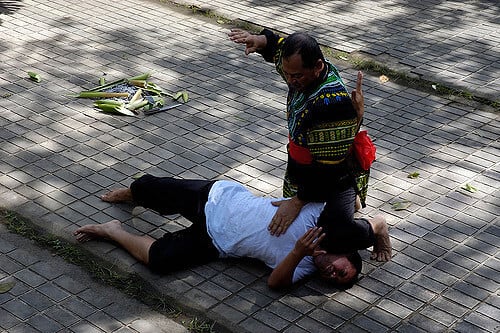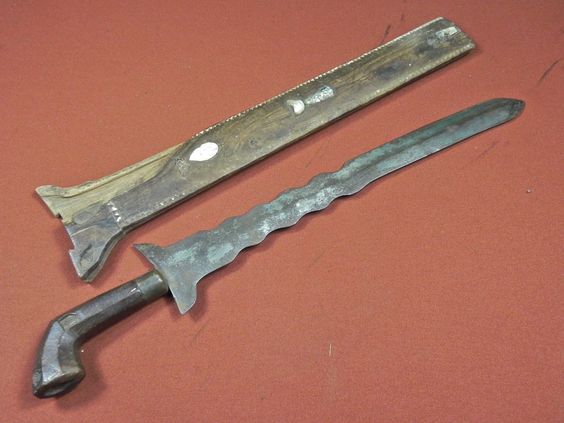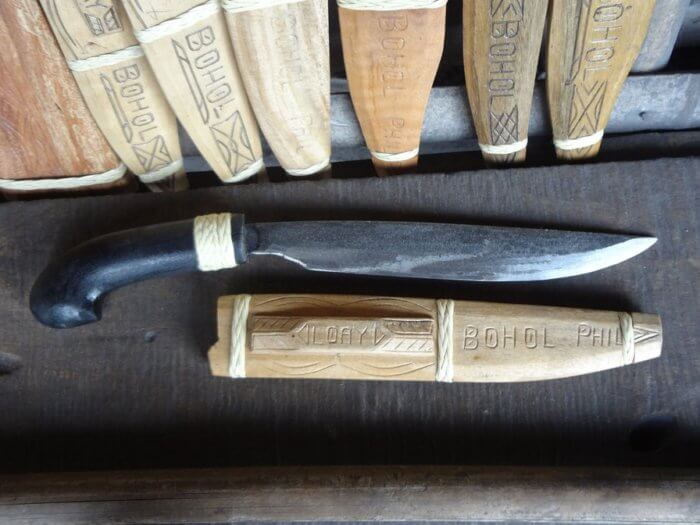Martial Art That Begins With S and Uses Swords
In this department, yous'll notice a diverseness of Filipino martial arts weapons including Filipino weapons of war. There are numerous diverse dialects in the state, and we've selected the most common terms for these weapons.
Empty Hand

This is the rarest among FMA weapons. The phrase "A weapon is simply the extension of the arm" is true when referring to FMA.
Filipino Martial Arts Styles Specializing in Empty Hands
Countless Filipino martial arts are entirely empty-hand fighting arts, like Pananjakman, Panantukan, Buno and Dumog whereas weapon-based arts like Eskrima and Arnis frequently identify the empty-hand as function of their technique and is ofttimes called "Pangamot".
When talking almost the empty paw technique, this doesn't just limit the use of the open palm or fist, as every natural body weapon is utilized in the FMA. The feet, shins, knees, hands, forearms, elbows, shoulders and caput are all used.
In the unusual Kino-mutai, bitter is a specialty. It is possibly the most misinterpreted facet of the FMA and continues to be the most heady to report.
Strike Fast and Powerful Like an Eskrima Grandmaster!
five Notable Arnis Grandmasters (from the Philippines) teach the secrets to fast and powerful striking. Click Here to Starting time Grooming
Sticks
In Eskrima, the virtually fundamental and widespread weapon is the "yantok." They are normally made from rattan, a low-price stalk of a Southeast Asian plant. Durable and hard still lightweight, it only tears up under the most horrible corruption and won't splinter like the wood, thus, making it a rubber training instrument.
Curt Sticks

Also known as palm sticks or Tabak Malii. Brusk sticks preparation is washed in twos – that is, the trainee grips one in every hand, at the centre portion of the stick.
By tradition, the weapons were constructed from steel, which includes a ring to put the finger(s), and the end portions were sharp and serrated, and occasionally include bladed edges intended for slashing or thrusting.
The sticks are utilized in thrusting and hooking movements to lock or disarm armed/unarmed opponents.
Single Stick

This is the staple of numerous Arnis/Eskrima techniques, while in a few (for example, Balintawak), it is the main weapon. In the country, it is known as Olisi (Cebuano) or as Baston (Visayan).
The stick is constructed from rattan, as well every bit from other dumbo hardwoods, like Kamagong or Yakal. The most prominent and perhaps the first proof of its use is the Mactan boxing with Moro warriors who were armed with burn down-hardened sticks.
It is substantially a training musical instrument and tin be utilized for blocking, thrusting, slashing, locking, hooking, disarming, choking, grappling and takedowns. Information technology tin can be gripped in paw (like in Escrima de Avanico) or in both hands (like in Escrima de Llave).
The stick tin be gripped in the centre, or at each end in an underhandedly or overhanded manner. The simplicity of the stick as a weapon too as the qualities it trains is probably the source of an incorrect myth to the inexperienced that Arnis and Eskrima are mere "stick-fighting."
Double Stick

They can exist utilized in the aforementioned mode as the unmarried stick. They can besides build upwards all the traits that a single stick tin can exercise. On the other hand, double stick training can help the trainee learn the empty-hand fine art of Eskrima and Arnis.
I particular double stick fashion which the Pampangueno tribe developed is called Sinawali which requires stick weaving in complicated patterns. This discussion is derived from "Sawali," the bamboo-rush weave pattern which the natives utilize for formatting and walling.
The Double sticks, peculiarly in sparring, develop body movement, footwork, and likewise instruct imperative empty-manus applications for in-fighting and sparring. Double stick movements are interchangeable with dagger and stick, likewise empty-manus and stick exercises.
Eskrima Weapons You Demand To Railroad train With
Grooming with these weapons will develop your coordination, speed and rhythm! Get your Free List Here.
Long Stick

Also chosen as staff, is another weapon uncommonly associated with FMA. The stick movements sometimes chosen "amara" are similar to the single stick. Slashes, hooks, figure eights, and thrusts are all utilized in the same way, other than using both hands.
Training in staff or long stick develops certain traits for empty-hand boot defences, too as human knee locks and takedowns. The long stick is gripped with both hands, palms up, palms down, or a combo of both. Past tradition, the staff was but a training instrument for the spear (Karasaik or Bangkaw).
The Panabas is also worth mentioning here because it belongs to this category. It is a halberd-like weapon, with a rounded blade fixed to a long staff. The blade's cut edge is on the inner portion of the curve, such equally a scythe, and the Panabas' length varies from 3-9 feet.
Brusque Blades
Instead of guns, Filipinos maintain the culture of blades as the primary tool. Today, numerous locals utilize blades as a tool to cut fruits, grass, and meat. Considering of their accessibility blades became the secondary weapons of Esrkima.
Unmarried Dagger

This has loads of uses, normally thrusting, hooking and slashing. It can be utilized defensively or offensively in dissimilar ways against a variety of weapons. Information technology can be utilized as an extra weapon to the sword or stick to disarm or rake the weapon of the opponents, or as a close-quarter shoving weapon.
It can be gripped pointing down or pointing up in either rear or front easily. The term "Balaraw" or simply "Baraw" is frequently utilized in the Visayas, referring to a dagger.
Balisong

The Balisong is a foreign weapon too. To the inexperienced, it is more than frequently known as the "butterfly knife." The term means "broken horn," and came from the terms "bali" (to intermission) and "sung" (horn).
Many traditional balisongs were carved from brute horns. Its origin is the town Balisong in Batangas, Philippines. It isn't clear whether the town derived its name from the weapon or if the weapon derived its proper noun from the town.
Double Dagger

Information technology can be utilized in many ways offensively, either through raking using the rear dagger and thrusting using the front dagger or through stick twirling then as to suit the daggers.
Information technology has a few parallels with dagger and stick, too as the multiple combos of stances and grips provide the trainee with an excess of alternatives in a fight situation. Empty-hand defence confronting an attacker armed with double daggers is certainly hard, if non impossible.
Long Blades
Kris

The Kris' shape makes it unique from other single-edged and double-edged daggers. It has a double-edged blade, and is undulating, permitting easy flow of claret from a wound. Past tradition, the dagger was sacrificial, and though it was utilized in the s of Philippines, its origin is thought to exist Malay.
In the state, in that location are loads of unlike types of Kris; wherein every region produces a Kris with unlike wave numbers in the blade.
Sword

The Sword is still taught to trainees of many diverse Eskrima and Arnis styles. Styles similar Kali Ilustrisimo are entirely blade based, and their trainees ready greatly in bladed weapons.
Drills including swords are frequently medium-long range and tin can highlight on sliding to a rival's hand or controlling a rival'south bladed weapon. Equally a thrust and cut weapon, it provides trainees with the certain insight into the details backside numerous stick drills.
Kampilan

This is perhaps one of the most well-known Filipino weapons because this weapon hit the valiant explorer Ferdinand Magellan a moment earlier his death. It is known for its branched handle representing the broad crocodile jaw.
Kampilan is a single-edged weapon, with a cutting edge about thirty inches long, with a tiny flared spikelet close to the tip. It was popularized by the Maguindanao and Iranun warriors and pirates of Mindanao and is the longest killing tool the Moros utilized. It can be gripped with one or both hands.
Barong

Another Moro weapon, the Barong, though the term "Barong" is a Tagalog word for a leaf-shaped bract. The Taganak and Tausugs from Tutle Island preferred it in shut fighting. The blade is near fifteen inches long and nearly 3 inches broad at the center. It is a double-edged weapon.
Sundang

The Sundang, based on the Kris, is doubled edged as well. It is a bit longer than the Barong, having a 20-inch blade length. The term "Sundang" is Visayan for whatever huge single or double-edged weapon.
Pinuti

The PInuti, a Visayan weapon, is a weapon of war preferred past Visayan warriors. Its design is simple, with a single blade only. The Bolo, another Visayan weapon, is larger, machete-similar, although still single-edged.
In Luzon, the Kris and Bolo'southward designs have acquired to modify weapons which both have the characteristics of the Kris and Bolo. Another term is Tabak which isn't oft utilized every bit earlier is a Tagalog word for curved or cutlass sword. It is perfect for close-range fighting.
Golok

The Golok is, in fact, a machete, with a huge, wide cutting border that looks like a butcher knife, with a single blade. The term "Golok" is, in fact, the Indonesian term for Machete, and the weapon is said to accept originated from Coffee, an island.
Combination
Sword and Dagger

The Spaniards brought numerous stuff to the country only did non leave several things behind. Of the few ongoing martial and cultural influences, the conquistadors left with the Filipino people, the sword, and dagger fighting style was 1 of them, which was and so popular in Spanish fencing.
This combo uses the flattering qualities of a short-thrusting weapon with a more than extensive cutting weapon. By tradition, the combo is known as "Espada y Daga." The Filipinos improved the Spanish fencing techniques to conform meliorate their combat styles, and developed their medium- and long-range sword and dagger fighting.
These days, stick and dagger (Olisi y Baraw) are utilized as a preparation weapon and takes in tie-ups, takedowns, and locks with both tools, methods which enable the use of a bract.
Flexible Weapons
Flexible weapons flourish in the Philippine archipelago too, though their utilize isn't too-liked equally the weapons abovementioned. Certain techniques, like Pananandata, have a broad display of flexible weapon styles.
Clearly, the garotte is a nominee in this category. However, not many techniques openly practise such methods. On the other hand, flexible weapons are vital and can be utilized to initiate necktie-ups, locks, strangles and chokes with many weapons on armed/unarmed opponents.
Another weapon, the Cadena too belongs to this section, since it shares the qualities of both flexible and sticks weapons.
Projectile Weapons
The projectile weapons are vast and various. Blowguns, bows, and slingshots were all frequent tools, specially for the Moros. Their use was less frequent with the influx of the heavily-armoured Castilian conquistadors even though they were yet utilized for tribal and hunting warfare.
Projectile weapons lack many techniques of Eskrima and Arnis de Mano and are possibly ane of the sections of the arts that ought to be re-examined.
Larn More:
- Filipino Bladed Weapons
- How to Make Arnis Sticks – three Brilliant Steps
- Awesome Escrima Sticks – Our Top 5 Best Picks
Source: https://stickfightingsport.com/filipino-martial-arts-weapons-a-complete-list/
0 Response to "Martial Art That Begins With S and Uses Swords"
Post a Comment